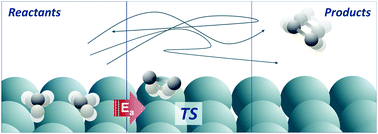First principles rates for surface chemistry employing exact transition state theory: application to recombinative desorption of hydrogen from Cu(111)
Abstract
We present first principles calculations of the reactive flux for thermal recombinative desorption of hydrogen from Cu(111). We follow a theoretical paradigm used successfully for gas phase reactions, where electronic structure theory (DFT-GGA) is combined with transition state theory (TST). Classical ab initio molecular dynamics trajectories initiated from a thermal distribution near the transition state provide dynamical corrections to the desorption rate. We use this to calculate and study the recrossing error of TST and to directly simulate thermal desorption experiments based on a high temperature permeation method. Transition state recrossing is strongly temperature dependent and is even important in a frozen Cu-atom model. It is not influenced by inclusion of electron–hole pair excitation at the level of the local density electronic friction approximation. We also present the kinetic energy resolved flux of desorbing H2 at elevated temperature. This provides a more direct way to compare first principles theory to experiment, with no need to invoke detailed balance.



 Please wait while we load your content...
Please wait while we load your content...